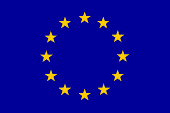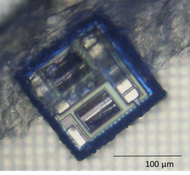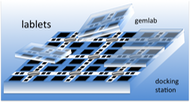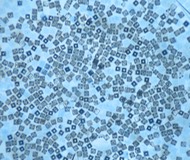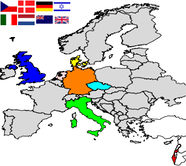MICREAgents is a three-year collaborative project in Unconventional Computing funded by Future Emerging Technologies (FET) in the EU FP7 program. 10 research groups have come together from across Europe (including Israel), together with a research group in New Zealand, with coordination by the Ruhr Universität Bochum to investigate a new kind of embedded computation in which novel artificial entities combine electronic and chemical functionalities.
The central idea of the project is to create an autonomous programmable microscale electronic chemistry on suspended particles, approaching the size of mammalian cells. These so-called lablets (target size 100µm) employ autonomous circuit elements (including power scavenging) and an active microstructured profile to self-assemble in solution in order to communicate with one another and exchange chemicals. The electronic processing should enable them to both direct such association reversibly and to control chemical reactions in the reaction enclosure created by assembly. Pairwise association can then be programmed and electronic signals employed to direct complex microscopic chemical syntheses or analysis tasks. This requires a code, akin to the genetic code and will provide a novel form of computation that microscopically links reaction processing with computation in autonomous mobile smart reactors. It is a next major step towards the integration of computation and reactive chemical processing in electronically programmable systems: it corresponds to a radical integration of autonomous chemical experimentation and represents a novel form of computation.
The project designed and built the first such lablets, with the integration of a supercapacitor for rechargeable power (20 min. operating time) increasing the size from 100x100x35µm without (CMOS1), first to 100x200x50µm (CMOS2) and finally to 140x140x50µm (CMOS3). A fabrication scheme for compressing the final lablets back to 100x100x50µm by placing the supercap on the back side with TSVs (through silicon vias) was worked out. A smart docking surface and addressable lablet arrays were also developed and found to be useful, not only for testing and interacting with lablets but also for controlling chemical concentrations adaptively in thin films, with reversible ion uptake and release controlling downstream DNA processing for DNAzymes, and for combinatorial optimization of surface coatings (e.g. catalysts). The sensor functionality of the dock allows all-electronic integrated experimentation. The powering of lablets by bipolar power and through the dock were investigated, with proof of principle through supercap coatings acquiring the necessary performance parameters. The reversible docking of lablets required a novel chemical approach involving pH-sensitive DNA structures forming electrode-targeted gels, and was tested on passive lablets and for reversible electronic triggering. Sensors for DNA and pH were developed that can be integrated on lablets. Chemical synthesis to set up DNA transfer between surfaces for lablet-lablet chemical communication was done. Lablets and the dock were investigated for future controlled drug release with examples of locally electro-triggered release of liposome contents implemented.
Final programmable lablet fabrication included support for locomotion, cooperative swarming activity, and a complete lablet “life-cycle” in which the electronic program information can be copied from lablet to lablet to setup the parent chemical properties. The diversity of programmable chemistry coupled to lablets was enhanced with developments in polyoxometalates, DNAzymes and DNA-block copolymers, as well as novel programmable galvanics making use of CMOS to connect different electrodes in subnets for processing in parallel.
The impact of MICREAgents in unconventional computing is as an implementation of von Neumann’s construction machine in an evolvable form with an electronic genome and practical spinoffs. Lablets will not be advanced enough for medical applications immediately, but it is certain that this pioneering research will help bridge the gap to smart e-drugs where smart chemical capsules approaching the size of cells can act reproducibly with intelligent programs to optimize microscopic treatments. Meanwhile a broad range of applications in microscopic chemistry can be developed.

